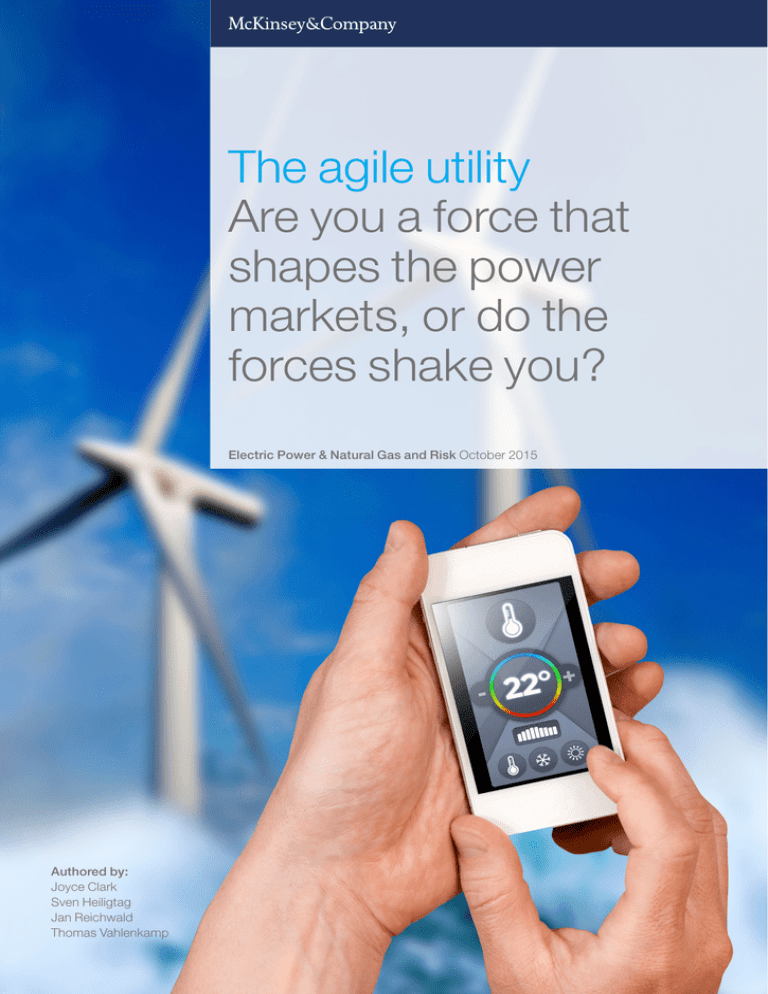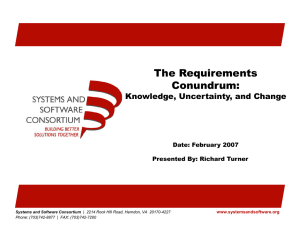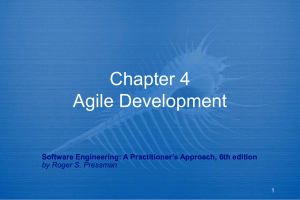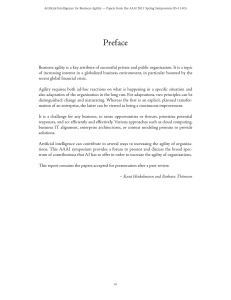The agile utility Are you a force that shapes the power markets, or do
advertisement

The agile utility Are you a force that shapes the power markets, or do the forces shake you? Electric Power & Natural Gas and Risk October 2015 Authored by: Joyce Clark Sven Heiligtag Jan Reichwald Thomas Vahlenkamp The agile utility – are you a force that shapes the power markets, or do the forces shake you? In the rapidly changing environment of the energy business, agility will be the key to success – or ­survival – for incumbent utilities. As fundamental trends on two fronts reshape the European electric power and natural gas (EPNG) landscape and rattle incumbent utilities, energy industry value pools are likely to move towards new ways of doing business. In the traditional asset-driven world, established utilities are scrambling to cope with ever-growing volatility, uncertainty, complexity, and ambiguity (VUCA), manifested in changes such as sudden policy shifts on nuclear power, the skyrocketing ramp-up of renewables, or national poker games on capacity mechanisms and carbon prices. The unprecedented collapse of demand growth and ongoing low spreads combined with global tremors in the oil and gas markets continue to put huge pressure on margins. As if this were not enough, technological advances and digital trends are also reshaping the energy sector, impacting traditional businesses and enabling new ones. Increasing digitization – particularly in downstream – is tearing apart and reconfiguring the traditional value chain, making historic sources of synergies obsolete while at the same time driving down both interaction and transaction costs. New business models These shifts in market trends along with developments in technology are accelerating the emergence of new business models with rapid mass customization and direct feedback loops for customer centricity (Exhibit 1). Exhibit 1 The utility business model is redefined by 2 forces: increased “VUCA” and the new digital world Industry forces impacting traditional business models (“VUCA”) Decreasing global fuel prices, low spreads, collapse of demand growth, e.g., oil prices, fracking, European wholesale markets Undecided technology and regulatory endgames, e.g., renewables, storage, capacity hangover, green subsidies, carbon price Evolving asset-driven business Digital forces disrupting traditional and enabling new business Digitization and reconfiguration of value chain, decrease in synergies, e.g., specialized digital natives, customer centricity, and mass customization Information/data economy, power as gateway to customer behavior – new players with advantages in skill and financial firepower New digital/customer-driven business SOURCE: McKinsey The agile utility – are you a force that shapes the power markets, or do the forces shake you? 3 The latest twist: increasing electrification – e-mobility, for example, and power-to-heat combined with real-time metering – has the potential to turn power consumption data into the ultimate gateway to customer behavior. If and when this happens, it will attract digital natives with the financial, analytical, and technological firepower to create a totally new information and data economy in the energy sector. This upheaval will result in a rapid shift in profitability from traditional to new digital value pools, offering enormous opportunities for new players and, potentially, for incumbent utilities that are willing and able to adjust to the market shifts and technological advances. Other industries, such as media, high tech, and telecommunications, have faced similar challenges in the past that may have even been more disruptive than today’s EPNG industry storm. However, the challenge can be mastered if the company understands the significance of the changes required and makes the effort needed to venture into the new territory. The transformation is especially challenging because not only do utilities need to become more agile, they must also remain flexible in adjusting their approaches and strategies over time as the industry and technologies evolve. These changes are far-reaching, and in the current environment, where margins are already under pressure, implementing these strategies might seem challenging. Declining margins, however, signal the need to adapt (Exhibit 2). Exhibit 2 Value pools are shifting considerably – asset value pools stabilizing, new digital/customer-driven value pools as new growth engine EPNG industry outlook European sector value pool EBIT1, EUR billions What you need to believe – move to an all electric world with electricity as ultimate data/ customer behavior source 98 18 17 63 141 31 30 80 2013 20201 Telecom industry Global mobile revenues USD billions 930 +365% New value pools RES Traditional Other value pools2 200 Late 1990s 650 New value pools – largely captured by new entrants 280 Traditional value pools – largely captured by incumbents 2010 1 2020 base case 2 In 2020, including, e.g., EUR 12 billion for performance improvement SOURCE: McKinsey 4 The agile utility – are you a force that shapes the power markets, or do the forces shake you? Where to play? At this junction, utility CEOs have to make strategic decisions on where and how to play – and this raises a fundamental question: focus on the asset-driven business only or play in both worlds? The buzz in the European energy landscape is already intense. Movement in this space includes: E.ON’s structural split and RWE engaging in talks with an Arabic investor and entering into a partnership with Google Nest. SunEdison is ramping up global YieldCos for onshore wind and photovoltaics (PV), and DONG Energy is exporting its leading offshore wind position and capital recycling model to new markets, starting with the US. Additionally, SolarCity and Sungevity are taking decentralized solar power generation to the next level, via a combination of software-based design of PV systems, databases for solar radiation and satellite maps, and customer-focused leasing models. Google and Apple are entering the power business, and not just acquiring customers but also assets: both are investing in large-scale PV parks. How to play? Based on an extensive cross-industry analysis, McKinsey has identified the three core agility paradigms and ten core agility capabilities that capture the concept of agility for an enterprise as a whole and that are key to successfully accessing value pools in both the traditional, asset-driven business as well as the new digital/customer-driven business (Exhibit 3). Exhibit 3 The learnings from other industries essentially boil down to 3 agility paradigms that encompass 10 core agility capabilities 3 agility paradigms 10 core agility capabilities Fast, better decision making and more dynamic portfolio and resource (re-)allocation 1 Internal and external sensing and shaping of trends and opportunities 2 Dynamic and rapid portfolio and resource (re-)allocation Flexible production systems and fast scale-up of new business opportunities 5 De-engineering and “flexibilizing” processes and roles 6 Digitally enabling operating system and business opportunity development 7 “From exploration to exploitation” – integrated sensing, seizing, and execution Bursting company boundaries and agile ways of working 3 New ways of financing and access to capital 4 De-biasing decision making 8 Open ecosystems and strengths-based partnerships 9 Cross-functional teams and end-to-end processes drive performance, line builds capabilities 10 From command-and-control to peer-based, distributed authority SOURCE: McKinsey The agile utility – are you a force that shapes the power markets, or do the forces shake you? 5 It is important to note that what each of the ten agility capabilities means in practice differs significantly – depending on whether they are applied in a traditional, asset-driven or in a digital/customer-driven business context. In the following, we will outline some of the more extreme moves – largely from agile digital/customer-driven businesses – but also highlight the differences in agility practices between the two models. 1. Internal and external sensing and shaping of trends and opportunities. Evolve from a passive, internal focus on industry trends towards a strong sensing capability across the entire organization, involving external partnerships and customers to shape the market. A first step both in asset-driven and digital/customer-driven businesses would be to complement today’s internal processes and perspectives with a number of selected external partnerships. As an example, Deutsche Telekom is involved in multiple engagements – including research with universities/labs, collaborations with incubators, and partnerships with venture capital (VC) boards – to observe (and potentially participate in) new start-up opportunities at an early stage. 2. Dynamic and rapid portfolio and resource (re-)allocation. Replace the limited number of options that are developed purely internally and finally decided by top management with a substantial portfolio of initiatives and options with internal marketplaces, external input, and VC-like approaches. In addition, transform static strategic planning into a stage-gate process, where multiple options are pursued on a small scale. The most promising initiatives will receive more capital in subsequent rounds and substantial resource allocations. As an example, DONG Energy is dynamically allocating people and financial resources based on a risk/return merit order on project level. Its flexible capital recycling model allows it to step up its commitments depending on actual hit rates. Even though portfolios of initiatives in asset-driven businesses can be somewhat smaller due to high capex needs per project, for example, there are first steps that should be taken. These companies, for instance, should increase the funnel intake via external input and improve the transparency on ideas by aggregating them in a companywide portfolio. Moreover, they should consider evaluating opportunities in different stages of maturity via stage-gate logic and – before investing beyond the point of return – assess the total capex requirements of singular projects and cluster risks in relation to the financial backbone. 3. New ways of financing and access to capital. Develop from the traditional focus on corporate financing and full ownership towards a variety of traditional and nontraditional financing instruments, in a wide universe of potential global investors and partners. A first step towards new ways of financing would be to implement selected partnerships with risk-sharing models. SunEdison, for example, spins off its sales activities into YieldCos and thereby more than doubles enterprise value due to valuation differences. 4. De-biasing decision making. Leave behind the traditional, purely internal decision making process, and accept that individuals and organizations have intrinsic decision biases that can be actively managed. RWE, for example, incorporated several de-biasing techniques such as “pre-mortem analysis” and challenging bodies such as “independent opinion” or “devil’s advocate” in its board decision making processes to counterbalance group thinking and confirmation biases.1 1 6 RWE received the Controller Award from Internationaler Controller Verein (ICV) in 2015 for its work on de-biasing decisions in controlling. Controlling & Management Review, 2/2015. See also http://www.finance-magazin.de/ bilanzierung-controlling/controlling/icv-controllerpreis-2015-geht-an-rwe-1343239/ The agile utility – are you a force that shapes the power markets, or do the forces shake you? 5. De-engineering and “flexibilizing” processes and roles. Move from very inflexible, highly specialized roles and processes towards highly flexible staff via a high standardization of roles and processes that allow flexible labor deployment, multiskilling, quick role shifting, and an adaptive production setup. This lever is of crucial importance especially in assetdriven businesses. Philips is one example of this, as they have started to standardize their roles, processes, and business units in order to increase company-wide staff mobility. They have effectively reduced the number of end-to-end processes and roles from over 300 to less than 100 by introducing a common operating language and an 80-percent standardization of processes. Other examples include carmakers that have cascaded action plans to adapt to swings in demand via flexible work time accounts and shift options. Early improvements in flexibility can be achieved via the initial standardization of selected processes and roles. For utilities with capex-intensive assets, flexible operations, portfolio-wide synergies, component management, and flexible workforce are fundamental to cost-competitive operations. 6. Digitally enabling operating system and business opportunity development. Develop away from traditional, mainly manual processes (based on paper and print) into a full virtual enterprise with customer-focused, end-to-end digitization, where each piece of information is accessible in real time. There is a two-speed architecture of digital enablement: in an asset-driven context, the initial focus is typically on digitally enabling the operating system with a focus on the core, at-scale processes and system. In digital/customerdriven businesses, the focus is on digitally enabling new business opportunities via rapid prototyping logic, e.g., apps. Sungevity, for example, combines satellite data and a proprietary digital application for rapid tailoring of its photovoltaic offering to customers. The first steps of full enterprise digitization include virtualizing internal processes, building and testing the required IT infrastructure, and establishing the needed skills. Preventive maintenance and production planning are key differentiators of agile asset-driven businesses that benefit from end-to-end digitization. Also, data analytics covering both supply and demand can generate value beyond singular generation assets. 7. “From exploration to exploitation” – integrated sensing, seizing, and execution. Often, units responsible for sensing and seizing (e.g., business development) are not given the authority to execute on their innovations, leading to a loss of momentum. Instead, a multitude of mostly independent units, with clear responsibility spanning from idea to execution, could speed up innovation, prototyping, and implementation. Schibsted, for example, rapidly scales up initiatives through independent performance cells (“speedboats”) with a “fail fast, fail small,” “test small and scale up” logic. And at Rocket Internet, conceptualization to launch of speedboats does not last longer than 100 days (“100-day rule”). The first step could be a virtual unit for sensing and initial seizing, with subsequent handover to clearly responsible business units. In a second step, utilities should push for a fast-paced development of customer-focused products and services, where low-capex options are tested and implemented rapidly, with a clear mandate and responsibility instead of rather slow corporate procedures. This could take the form of New Downstream in existing markets, market-entry initiatives with grid or renewables, or complete new business activities such as customer-focused digital services or real estate. 8. Open ecosystems and strengths-based partnerships. Some large-scale companies tend to focus on in-house solutions with closed technology platforms where only the owner The agile utility – are you a force that shapes the power markets, or do the forces shake you? 7 can develop and implement new ideas. An agile enterprise would follow an open-source, strengths-based partnership model that focuses on putting the customer first. This model is optimized for a wide range of co-creation and innovation models and encourages partners and customers to develop and market their own ideas. Tesla, for example, released its patents for electric vehicle charging infrastructure in the spirit of creating a new “open source” standard and speeding up the development and rollout of electric mobility while keeping its license fees. A first step towards an open ecosystem would be to build selected collaborations and partnerships with other companies, including innovative niche players in the electric power and natural gas value chain as well as with players from other, adjacent businesses. A venture capital approach to dynamically taking an equity stake can also be part of the game. Today, several utilities consider themselves to be dominant gatekeepers to the customer, trying to build their own closed, technological platforms for decentralized generation and demand as well as data management. 9. Cross-functional teams and end-to-end processes drive performance, line builds capabilities. Build a cross-functional, collaborative organization with end-to-end performance management and a line function focused on capability building. At Google, for example, people move fluidly through the organization, supported by an open “job market” (e.g., different social network mechanisms). People even switch roles across hierarchy levels, and collaboration is seen as a key value.2 A first step towards creating a collaborative organization would be to build cross-functional teams around concrete business ideas/initiatives and establish those teams as the primary performance units. 10. From command-and-control to peer-based, distributed authority. Facilitate a “fast failure” and learning culture by delegating and distributing authority to the primary performance units. This requires a strong cultural shift as line managers refocus their day-to-day activities towards capability building, people development, and resource deployment, while day-to-day performance management of team members is done in the performance cells but not by the line manager. One example of a company following the idea of distributed authority via the dictum “trust over control” is Spotify, which organizes its day-to-day business in crossfunctional teams (“squads”) that have end-to-end project responsibility. The way forward to greater agility In the European utility landscape, we expect to see a variety of player-specific journeys towards more agility – each one depending on the company’s individual starting point and on its strategic decisions at the point of junction, i.e., the decisions on where and how to play in the traditional and the new business system. Recognizing the challenge in bringing these mindsets to life, McKinsey has developed a structured three-step approach to becoming more agile in day-to-day operations while concurrently maintaining other important KPIs, especially regarding cost effectiveness and clear focus. 2Sources: Jarvis, Jeff, What Would Google Do? Reverse-Engineering the Fastest-Growing Company in the History of the World, 2011; Schmidt, Eric and Rosenberg, Jonathan, How Google Works, 2014; Web search, e.g., http://www.strategyand.pwc.com/innovation1000, https://www.ibm.com/developerworks/community/ blogs/ibmandgoogle?lang=en 8 The agile utility – are you a force that shapes the power markets, or do the forces shake you? First, a company should identify its future strategic and structural setup hand in hand with the strategy and finance capabilities outlined above. This will involve a granular analysis of the old and new building blocks along the energy value chain, including their key ­success factors and how strongly they are in place at the company. The next stage is to sketch out similarities and synergies across them to build one or more player-specific archetypes based on given capabilities, stakeholder feasibility, and expectations regarding market developments. Beyond these structural and strategic decisions, incumbents will ideally establish a network of external stakeholders for continuous exchange. This will help build alliances with favorable interest groups and minimize the hostility of external stakeholders. They could also participate in a number of VC fund supervisory boards to keep up with the latest trends. Second, operational and commercial agility capabilities are crucial to achieve measurable impact and support the transformation into the target status. Building on experience, especially from the automotive, consumer goods, and telecom industries, a utility can, for example, increase the flexibility of its workforce: standardized roles and processes in combination with adaptable work time accounts make it easier to rotate and shift resources across the organization, swiftly responding to changing market demands. Operational and commercial interventions should also include the next level of lean programs where the traditional cost and waste focus is complemented by an agility lens. Beyond that, digital interventions across the value chain will transform traditional utility processes into the virtual realm. Sensors for real-time monitoring of high-technology assets enable preemptive, predictive maintenance, while big data analytics of (decentralized) assets or customer behavior enables rapid product innovation. As with oil and gas, innovative digital delivery models from the more advanced fields of retail banking, consumer goods, and manufacturing are transferable to the energy sector. Agility in operations and commercial functions needs to establish methods to move swiftly from idea generation to implemen­tation, to increase the frequency of product launches, and to push the success rate of new ideas. Third, cultural and organizational agility capabilities are crucial for sustainable companywide transformation, enabling and anchoring all other measures. The mindset shift to a more entrepreneurial, outward-oriented culture is a long-term journey with open feedback loops and outside-in mirroring along decision making processes across all levels. It will also be necessary to fundamentally adapt performance management systems and promotion processes, partially building on the best practices of digital natives, such as Google or Spotify. Substantial external hiring to achieve a critical mass in crucial business units can generate true impact: Deutsche Post has done this effectively for their digital unit. External secondments to innovative start-ups in Silicon Valley or the Middle East, as pursued by selected media and utility players, can support the company’s cultural ­transformation. Today’s industry storm offers significant opportunities to transform incumbent utilities into more dynamic and profitable enterprises. Agile leaders will achieve the levels of boldness, effort, and open-mindedness that are essential to guide their companies into uncharted waters and successfully shape today’s new value pools for profitable growth. The agile utility – are you a force that shapes the power markets, or do the forces shake you? 9 If you have any queries, please contact: Joyce Clark Phone: +49 211 136 4629 E-mail: joyce_clark@mckinsey.com Sven Heiligtag Phone: +49 40 3612-1346 E-mail: sven_heiligtag@mckinsey.com Thomas Vahlenkamp Phone: +49 211 136 4390 E-mail: thomas_vahlenkamp@mckinsey.com Electric Power & Natural Gas and Risk October 2015 Design contact: Visual Media Europe Copyright © McKinsey & Company www.mckinsey.com





